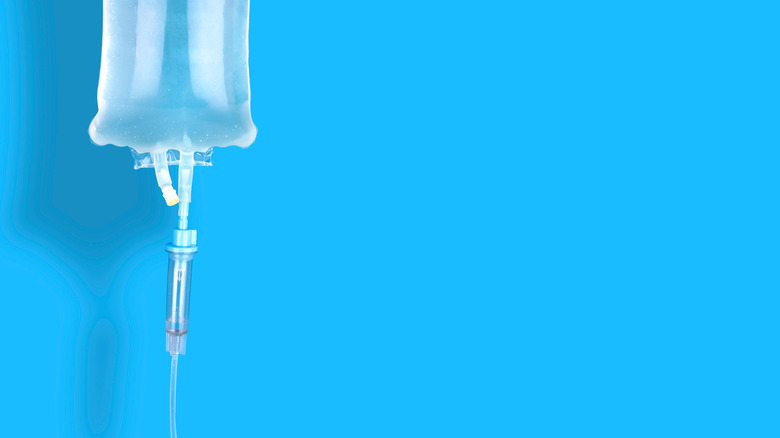How Do IV Drips Work?
IV drips, also known as IV therapy, are growing in popularity among wellness-seekers. Gone are the days when you needed a doctor's order to receive an IV of nutrients. The general public can now receive it from the comfort of their homes, at a spa, or even a mobile clinic. According to Healthline, IV drips are advertised to come with a wide range of benefits including improved hydration, boosted immunity, and relief from hangovers.
The process is simple. Each session lasts between 30 to 45 minutes. A nurse places a catheter in a vein using a needle (per Bounce Hydration). The catheter is attached to a bag containing the nutrition, typically an assortment of vitamins, minerals, and electrolytes.
Lindsay Slowiczek, a drug information pharmacist, tells Healthline, "This allows the nutrients to be absorbed quickly and directly into the bloodstream, a method that produces higher levels of the vitamins and minerals in your body than if you got them from food or supplements."
The treatment can be costly. According to Everyday Health, an IV drip session typically costs between $150 and $400. IV therapy is popular among celebrities including Kim Kardashian, Chrissy Teigan, and Adele.
According to Cedars Sinai, there is little evidence that IV drips are effective. Dr. Debra Sullivan, a nurse educator, tells Healthline, "These treatments are usually not covered by insurance and are pretty pricey... so clients are likely to want the therapy to work since they just paid a lot of money for it."
What are the risks?
The health risks of IV therapy treatments are still being evaluated, but some medical experts express concern. Anne de la Hunty, a senior nutrition scientist for the British Nutrition Foundation, tells Harpers Bazaar, "Injecting anything into the bloodstream comes with risks such as air bubbles in the syringe that can transfer to the bloodstream, allergic reactions and infection, which are more likely to occur if the person administering the injection is not properly qualified."
There are also arguments that directly injecting nutrients into the bloodstream can be risky because it bypasses the body's ability to filter them. Registered dietitian nutritionist Lauren Harris-Pincus explains to Health, "By taking IV vitamins you are bypassing your body's normal digestive process that has built-in safeguards for absorption, meaning you could end up with too much of some things."
Those in favor of IV drips say it provides a rapid way to receive nutrients and feel better. If you're considering the treatment, it's important to know exactly what is going into your body, but doctors say the same results can be achieved far more affordably through drinking fluids and eating healthy foods (per Cedar Sinai). Dr. Sam Torbati, co-chair of Emergency Medicine at Cedars-Sinai says, "These treatments are mostly harmless and really just result in people making expensive urine."


